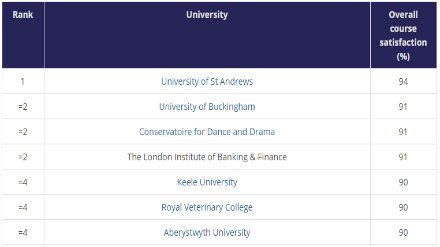The Times Higher Education World University Rankings are the only global performance tables that judge research-intensive universities across all their core missions: teaching, research, knowledge transfer and international outlook. We use 13 carefully calibrated performance indicators to provide the most comprehensive and balanced comparisons, trusted by students, academics, university leaders, industry and governments.
The performance indicators are grouped into five areas:
Teaching (the learning environment)
Research (volume, income and reputation)
Citations (research influence);
International outlook (staff, students and research)
Industry income (knowledge transfer)
《泰晤士高等教育》世界大学排名是世界上仅有的根据所有核心任务对研究型大学进行评判的全球大学排名榜单。这些核心任务包括教学、科研、知识转化和国际展望。我们根据13项精心校准的评估指标列出大学排名,以期提供得到学生、学界、大学领导、行业和政府认可的最全面而均衡的选校对比。
考核指标分为以下五个方面:
教学(学习环境)
科研(论文数量、收入和声誉)
论文引用量(研究影响力)
国际展望(员工、学生和科研)
产业收入(知识转化)。
1.教学
Teaching (the learning environment): 30%
Reputation survey: 15%
Staff-to-student ratio: 4.5%
Doctorate-to-bachelor’s ratio: 2.25%
Doctorates-awarded- to-academic-staff ratio: 6%
Institutional income: 2.25%
The most recent Academic Reputation Survey (run annually) that underpins this category was carried out in January to March 2017, attracting 10,568 responses. It examined the perceived prestige of institutions in teaching. The responses were statistically representative of the global academy’s geographical and subject mix. The 2017 data are combined with the results of the 2016 survey, giving more than 20,000 responses.
As well as giving a sense of how committed an institution is to nurturing the next generation of academics, a high proportion of postgraduate research students also suggests the provision of teaching at the highest level that is thus attractive to graduates and effective at developing them. This indicator is normalised to take account of a university’s unique subject mix, reflecting that the volume of doctoral awards varies by discipline.
Institutional income is scaled against academic staff numbers and normalised for purchasing-power parity (PPP). It indicates an institution’s general status and gives a broad sense of the infrastructure and facilities available to students and staff.
教学(学习环境):30%
声誉调查:15%
教员/学生比例占比:4.5%
博士/学士比例占比:2.25%
制度收入:2.25%
这个类别的评估以每年发布的学术声誉调查为基础。最新的学术声誉调查于2017年1月至3月实施,收到了10,568 份回复。它考察的是大学在教学指标在别人眼中的声望。这些回复统计代表了不同地区不同、不同学科人们的见解。2017年的数据结合了2016年的调查,增加了2万多份回复。
在被调查人群中,有相当比例的研究生研究型学生。他们的回答不仅让人们知道大学在新一代人才培养问题上的态度,而且让我们对最高层次的研究生教学有了一定了解。从他们的回答可以看出某个大学的研究生教育为什么吸引他们,以及在培养学生上的效果。我们对这项指标进行了标准化处理,以便能考虑到大学在学科上的独特结合,以便能反映不同学科博士学位数量的差异。
制度收入根据专业教员规模进行调整,并针对购买力平价进行标化处理。制度收入表明的是大学的的整体地位,可以让我们对大学向师生提供的基础设施和设备有一个宽泛的了解。
2.科研
Research (volume, income and reputation): 30%
Reputation survey: 18%
Research income: 6%
Research productivity: 6%
The most prominent indicator in this category looks at a university’s reputation for research excellence among its peers, based on the responses to our annual Academic Reputation Survey.
Research income is scaled against academic staff numbers and adjusted for purchasing-power parity (PPP). This is a controversial indicator because it can be influenced by national policy and economic circumstances. But income is crucial to the development of world-class research, and because much of it is subject to competition and judged by peer review, our experts suggested that it was a valid measure. This indicator is fully normalised to take account of each university’s distinct subject profile, reflecting the fact that research grants in science subjects are often bigger than those awarded for the highest-quality social science, arts and humanities research.
To measure productivity we count the number of papers published in the academic journals indexed by Elsevier’s Scopus database per scholar, scaled for institutional size and normalised for subject. This gives a sense of the university’s ability to get papers published in quality peer-reviewed journals. This year, we devised a method to give credit for papers that are published in subjects where a university declares no staff.
科研(数量、收入和声誉):30%
声誉调查:18%
科研收入:6%
科研生产力:6%
这个类别也是依据我们每年公布的学术声誉调查。这个类别最显著的指标考察的是大学科研在同行中的口碑。
科研收入根据专业教学规模而定,并针对购买力平价进行调整。科研收入可能会收到国家政策和经济状况影响,因此是有争议的。但是,科研收入对世界级研究来说是非常重要的。鉴于这个理由及科研收入受到同行竞争和评价影响的原因,我们的专家建议将它视为有效。为了将各大学学科面貌纳入考量,为了能反映科学学科的科研补助通常高于社科、艺术和人文学科的事实,我们对科研收入指标进行了全面的标化处理。
为了评估科研生产力,我们根据Elsevier’s Scopus 数据库,对单位学者在学术期刊上发布的论文数量进行了统计,并根据大学规模、学科进行了调整和标化处理。这便于我们对大学在优质同行评论期刊发文的能力有一个认识。今年,针对没有员工的学科,我们发明了新的方法对该学科的论文进行考量。
3.引用量
Citations (research influence): 30%
Our research influence indicator looks at universities’ role in spreading new knowledge and ideas.
We examine research influence by capturing the number of times a university’s published work is cited by scholars globally. This year, our bibliometric data supplier Elsevier examined almost 62 million citations to more than 12.4 million journal articles, article reviews, conference proceedings and books and book chapters published over five years. The data include the 23,000 academic journals indexed by Elsevier’s Scopus database and all indexed publications between 2012 and 2016. Citations to these publications made in the six years from 2012 to 2017 are also collected.
The citations help to show us how much each university is contributing to the sum of human knowledge: they tell us whose research has stood out, has been picked up and built on by other scholars and, most importantly, has been shared around the global scholarly community to expand the boundaries of our understanding, irrespective of discipline.
The data are normalised to reflect variations in citation volume between different subject areas. This means that institutions with high levels of research activity in subjects with traditionally high citation counts do not gain an unfair advantage.
论文引用数量(科研影响力):30%
我们的科研影响力指标考察的是大学在传播新知识和新思想上扮演的角色。
为考察大学的科研影响力,我们对大学出版物被全球学者引用的次数进行了统计。今年,我们的文献数据提供者Elsevier 考察了近6200万段引文,涉及最近五年里发表的1240万以上期刊论文、文献评论、会议录、书籍和作品章节。这个数据囊括了Elsevier’s Scopus 索引到在2012年到2016年新出现的2万3千种学术期刊和出版物。Elsevier也收集了这些出版物从2012年到2017年六年里被引用的引文。
引文有助于我们知道各大学对人类知识的贡献程度。引文可以告诉我们哪些大学的科研已经脱颖而出,已经被其他学者引文并借鉴。最重要的是,引文可以让我们知道哪些大学的科研在全球学界得到了共享,扩展了我们的认知领域(不考察学科)。
为反映不同学科在引文数量上的差异,我们对数据进行了标化处理。这位意味着,在引用数量通常较多的学科上积极从事高水平科研的大学,不会理所当然地占据优势。
4.国际展望
International outlook (staff, students, research): 7.5%
International-to-domestic-student ratio: 2.5%
International-to-domestic-staff ratio: 2.5%
International collaboration: 2.5%
The ability of a university to attract undergraduates, postgraduates and faculty from all over the planet is key to its success on the world stage.
In the third international indicator, we calculate the proportion of a university’s total research journal publications that have at least one international co-author and reward higher volumes. This indicator is normalised to account for a university’s subject mix and uses the same five-year window as the “Citations: research influence” category.
国际展望(员工、学生和科研):7.5%
国际生/国内生比例占比:2.5%
国际员工/国内员工比例占比:2.5%
国际合作:2.5%
想在国际舞台上获得成功,大学就必须有能力吸引世界各地的学生和教员。
在第三项国际指标(国际员工/国内员工比例)中,我们统计了大学的国际合著和高销售量出版物在总科研期刊出版物中的占比。为了将大学学科混合纳入考量,我们对这项指标进行了标化处理,并沿用了五年来使用的“论文引用量:科研影响力”类别。
5.产业收入
Industry income (knowledge transfer): 2.5%
A university’s ability to help industry with innovations, inventions and consultancy has become a core mission of the contemporary global academy. This category seeks to capture such knowledge-transfer activity by looking at how much research income an institution earns from industry (adjusted for PPP), scaled against the number of academic staff it employs.
The category suggests the extent to which businesses are willing to pay for research and a university’s ability to attract funding in the commercial marketplace – useful indicators of institutional quality.
产业收入(知识转化):2.5%
大学应该有能力帮助产业创新、发明,为产业提供咨询,这已经成为当今全球学界的一个核心使命。这个类别努力反映大学在知识转化上的表现,考察了大学从产业中所获的科研收入,并根据专业教员数量进行了调整。
这个类别表明了企业为科研付费的乐意程度,以及大学在商业市场上吸引资金的能力。这些都是衡量制度品质的实用指标。
以上内容由留学群独家翻译,版权归留学群所有,未经留学群授权许可,任何公司任何人不得复制和转载,违者必追究法律责任!



